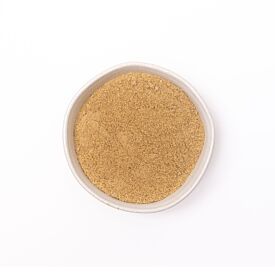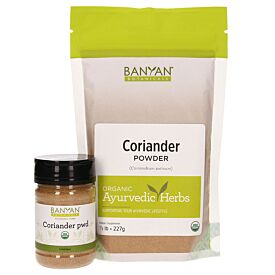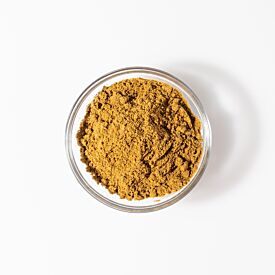Pitta and the Six Tastes

Pitta is primarily composed of the fire and water elements, which make pitta light, sharp, hot, oily, liquid, spreading, and subtle. Because of these characteristics, pitta is balanced by the sweet, bitter, and astringent tastes and aggravated by the sour, salty, and pungent tastes.
Below, you’ll find a deeper understanding how each taste specifically affects pitta, as well as the impact that different flavors of experience can have on pitta.
The Sweet taste balances pitta because:
- it is primarily composed of the earth and water elements and is cooling, heavy, soft, soothing, grounding, and nourishing.
- it has a sustained cooling and anti-inflammatory effect on the body, which offsets pitta’s tendency toward excess heat and inflammation.
- it relieves excess thirst and pacifies burning sensations.
- it helps to soothe and rejuvenate important pitta sites like the skin, the complexion, and the hair.
- it activates downward moving energy in the body, grounding pitta’s lightness and redirecting its tendency to rise in the body.
- it has a soothing effect on pitta’s sharply focused mind.
The sweet taste should be minimized when there is excess mucus, excess heaviness, excess fat, and excess sleep – these imbalances are not typically associated with pitta, but can still be present in people with pitta constitutions or imbalances.
The Bitter taste balances pitta because:
- it is primarily composed of the air and ether elements and it is extremely cold and dry.
- its cold quality alleviates thirst, reduces fevers, and helps to clear excess heat and inflammation.
- it dries the tissues and counters excess oiliness.
- it cleanses and purifies the blood and the liver—important pitta sites.
- it benefits the skin and relieves common pitta imbalances such as burning, itching, or swelling.
The bitter taste should be minimized in cases of elevated vata, excess cold quality, extreme dryness or roughness, emaciation, or a serious deficiency of any kind. While these discomforts are not typically associated with pitta, they can still be present in people with pitta constitutions or imbalances. The bitter taste is also best minimized during pregnancy.
The Astringent taste balances pitta because:
- it is primarily composed of the air and earth elements and is dry, cold, and heavy – all qualities that pacify pitta.
- its cooling nature relieves excess heat and inflammation.
- it helps to dry excess pitta by absorbing moisture and oil, which relieves excess sweating, stops leaking fluid, and can help to correct bleeding disorders.
- it has a specific affinity for the colon and can counter pitta’s fast moving digestion by binding the stool and correcting diarrhea.
- its ability to act as a vaso-constrictor can counter pitta type discomforts like migraines – a result of the hot, sharp qualities causing a forceful flow of blood and triggering vasodilation.
- it tends to promote groundedness, which helps to soothe pitta’s light, sharp mind.
The astringent taste should be minimized in cases of elevated vata, constipation, or when there are blockages of any kind in the body. While these imbalances may not be associated with excess pitta, they can still be present in people with pitta constitutions or imbalances.
The Sour taste aggravates pitta because:
- it is primarily composed of the earth and fire elements, which make it light, liquid, oily, moistening, and hot – all qualities that aggravate pitta.
- its heating nature tends to increase thirst and exacerbate pitta’s natural heat.
- it is moistening and can trigger water retention, which aggravates pitta’s liquid and oily qualities.
- its acidic nature can trigger heartburn, ulcers, and other pitta type indications of excess heat and sharpness in the digestive tract.
- it can exacerbate sensitivity in the teeth and eyes.
- it can disturb the blood, aggravating skin issues such as itching, rash, acne, eczema, and psoriasis.
- it can excite pitta’s strong appetite and fan the fire of an over-active metabolism.
- it stimulates peristalsis and can accelerate the cycle of elimination.
- it aggravates pitta’s sharp and focused mind and can trigger pitta type emotions like anger, criticism, jealously, and selfishness.
The Salty taste aggravates pitta because:
- it is primarily composed of the water and fire elements (the same elements which predominate pitta), which make it oily, moistening and warm.
- it stimulates the metabolism and can aggravate pitta type digestive issues like hyperacidity, vomiting, ulcers, and intestinal inflammation.
- its warming nature can increase thirst, aggravate excess heat and inflammation, irritate pitta type skin conditions, and cause burning sensations.
- its moisturizing quality can provoke pitta and lead to sodium and water retention.
- it has an affinity for the blood and can increase blood pressure or aggravate bleeding disorders.
- it is associated with graying hair and balding – both common signs of elevated pitta.
- it can evoke irritability.
The Pungent taste aggravates pitta because:
- it is primarily composed of the fire and air elements, which make it hot, light, and sharp – all qualities that aggravate pitta.
- it is the very hottest of all the tastes and can easily provoke pitta’s natural heat.
- its fiery nature increases circulation, encourages sweating, and causes excess thirst.
- it is intensely stimulating to the digestive fire, which for pitta can cause nausea, heartburn, ulcers, intestinal discomfort, inflammation, and diarrhea.
- it tends to thin the blood, dilate the vessels, and break up clots – all pitta type traits.
- it can aggravate skin conditions and cause burning sensations.
- it can deplete sexual potency by burning the reproductive tissues.
- its lightness and upward movement mirror and exacerbate common pitta tendencies.
- it can easily trigger pitta type emotions of aggressiveness, irritability, anger, competitiveness, and jealousy.
Pitta and the Flavor of Experience
It is not uncommon for some of the six tastes to be used to describe certain types of emotions, experiences, and personalities. Compassion, kindness, and caring indicate a certain sweetness. We can easily imagine what a salty character’s personality might look like, and we’ve all encountered someone who has grown bitter through the years. Making adjustments to the energies we’re exposed to can impact all of the doshas, but is especially effective for balancing the subtle nature of vata and pitta. When it comes to balancing pitta, there are a few important take away messages regarding the flavor of your life, relationships, and experiences.
- In general, relationships and experiences that are infused with the sweet quality are deeply pacifying for pitta. They soften pitta’s sharpness, ground upward moving energy, and settle undue intensity. Sweet experiences that would calm pitta might include receiving a relaxing massage, taking some time to simply absorb the soothing sights and sounds of the natural world, going on a romantic date with your partner, or prioritizing a loving self-care practice on a regular basis. There are many ways that we can increase the sweetness of our daily experience, and chances are that all of them will be deeply supportive of pitta.
- Pitta types may be naturally drawn to dry humor (think astringent) or a hint of cynicism (think mildly bitter), which, in moderation, can provide some of the drying and cooling qualities that actually balance pitta.
- On the other hand, sour experiences that trigger resentment, jealousy, or anger will tend to be exceptionally pitta provoking.
Remember, Ayurveda views taste – from the most tangible sensory experience to the subtlest energetic influence – as an essential therapeutic tool. While each of the six tastes has a vital role to play, the perfect combination of tastes can vary widely from one person to the next. When it comes to balancing pitta, the sweet, bitter, and astringent tastes tend to be the most supportive, while too much of the sour, salty, and pungent tastes can be decidedly pitta provoking.
If you feel like you need a more concrete understanding of any of the six tastes, or would like to see some examples of each one (in the way of foods, herbs, spices, emotional experiences, or mental attributes), please explore these introductory profiles:










